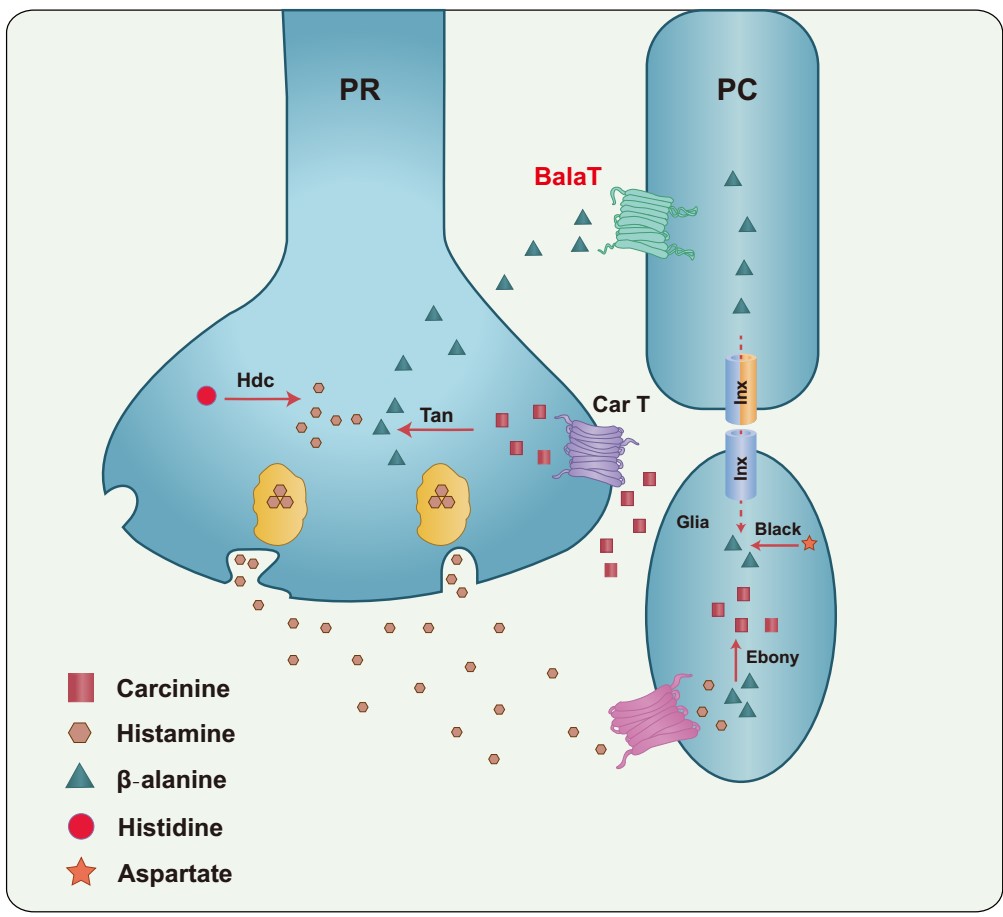Research News
Studies from Dr. Tao Wang’s laboratory discover that a novel β-alanine transporter is required for visual neurotransmission in Drosophila
On Augest 14th, 2017, Dr. Tao Wang’s laboratory published in eLife a paper titled "The β-alanine transporter BalaT is required for visual neurotransmission in Drosophila". Researchers studied the mechanism of neurotransmitter recycling in fruit fly, and revealed a β-alanine transporter are required for visual neurotransmission.
Neurotransmitters act as a messenger in the chemical synaptic transmission, they play an important role in the normal physiological function of animals. Neurotransmitters are usually recycled after their release to maintain the capacity of synaptic transmission. Glial cells clear neurotransmitters from synaptic clefts, and a network between neuron and glia is required for recycling neurotransmitters for sustained signaling. In fruit fly, Drosophila, photoreceptor cells use histamine as their major neurotransmitter to activate histamine-gated chloride channels (HisClA) on large monopolar cells (LMCs) in the lamina and hyperpolarize these postsynaptic neurons. Histamine recycling has particular importance for sustained, light-induced synaptic transmission, as visual transmissions signal at high frequencies. The released histamine is recycled through neighboring glia, where it is conjugated to β-alanine to form carcinine. After delivered back to photoreceptors, carcinine is hydrolyzed to release histamine and b-alanine. This histamine is repackaged into synaptic vesicles, but it is unclear how the b-alanine is returned to the laminar glial cells for efficient histamine clearance and reuse.

To reveal mechanisms of β-alanine recycling, we screened head-enriched putative transporter genes for the ability to transport β-alanine in vitro. This led to identify an SLC22 family member, which we named BalaT (Beta-alanine Transporter). BalaT is expressed in retinal pigment cells, into which β-alanine is taken up and stored. Loss of BalaT disrupts neurotransmission at photoreceptor cell synapses, and thus balat mutant flies are blind. Furthermore, the gap junction proteins Inx1 and Inx3 were required in retinal pigment cells for β-alanine trafficking back to laminar glial cells and sustaining visual neurotransmission. We therefore provide evidence for a novel β-alanine recycling pathway, in which β-alanine that is released from photoreceptor cells is taken up and stored by retinal pigment cells, and then delivered to laminar glia via gap junctions, where histamine is inactivated by conjugation with β-alanine. Our work reveals a BalaT-dependent β-alanine trafficking pathway that is critical for maintaining histamine levels in neurons, and provides direct evidence for a long-distance neurotransmitter trafficking that involved intercellular networks among photoreceptor cells, retinal pigment cells and laminar glial cells.
PhD students Yongchao Han and Liangyao Xiong from the Tao Wang’s laboratory are co-first authors of the study; other contributors include Dr. Ying Xu and TianTian from the Tao Wang’s laboratory. Dr. Tao Wang is the corresponding author. The study was supported by the Chinese Ministry of Science and Technology 973 Grants, and was conducted at the National Institute of Biological Sciences, Beijing.



